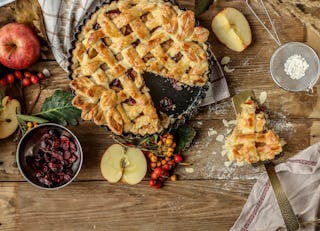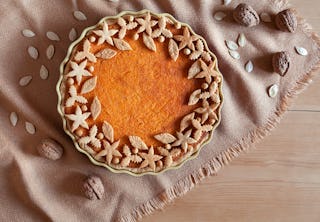
When we think about sitting down to Christmas dinner, we may think about the tables overflowing with delicious desserts – pies, cakes, candies, and more! Some of the classic treats we eat each year have been around for centuries and we’ve broken down the interesting history of those we see most often.
Fruitcake
Most people either love or hate fruitcake! While Americans derived this Christmas treat from British Christmas pudding (steamed cake flavored with dried fruit), it actually originated in Roman times. Romans mixed pine nuts, barley mash, pomegranate seed, raisins, and honeyed wine and formed it into a cake.

In the 1500s, sugar became less expensive and the British began to realize that they could preserve fruit longer by soaking it in a lot of sugar. British royalty began to eat fruitcake at celebrations, like weddings and holidays.
And, of course, it eventually became a Christmas tradition here in America, where we have a love/hate relationship with the long-lasting dessert. In fact, some towns even have fruitcake tosses, where they use catapults and cannons to destroy their fruitcakes.
Apple pie
No, the classic American apple pie isn’t actually American! The original form of apple pie was invented in the Middle Ages, where they baked apples, figs, raisins, and pears in a pastry shell. And there were two other big differences – they didn’t use sugar (it was expensive and rare!) and the pastry shell was meant to be a container and wasn’t eaten.

Sugar was added when it became more prevalent in the 1500s and, later, early American settlers started using the crab apples they found in the colonies to make pies. Pilgrims brought over apple seeds from England and quickly began growing the easy crop.
The classic dessert became nostalgic and beloved in America, associated with home, love, and delicious food. And, of course, that’s why many of us include it in our Christmas meals.
Pumpkin Pie
Who doesn’t love pumpkins (and pumpkin spice)? Well, pumpkins were actually some of the very first gifts brought to settlers from the Native Americans. The colonists would hollow out a pumpkin shell, fill it with honey, milk and spices, and bake that in hot ashes. That looks a lot different than our modern pumpkin pie!

Over time, we began baking pumpkin pie in a crust and the creation of canned pumpkin in the 19th century made the pie even more of a holiday staple.
Gingerbread
Gingerbread men, gingerbread houses, gingerbread loaf cake – gingerbread is certainly a must-have around the holidays! The spicy, sweet, molasses-based cake is easy to form into whatever shape you’d like.

In fact, even in the Middle Ages, hard cookies were cut in the shape of kings and queens and decorated just like we do today. In the 16th century, Germans started building gingerbread houses, especially after Hansel and Gretel was written.
Now, well, we make gingerbread cookies in all kinds of shapes and gingerbread houses decorated to fit our favorite themes!
Christmas cookies
And, of course, what is Christmas without Christmas cookies? Memories are made decorating each and every star, bell, angel, and ornament.
But this favorite holiday treat actually goes back to the Middle Ages! During that time period, sugar was expensive and rare, so they could only afford to bake for special occasions, like Christmas. They used nutmeg and cinnamon to bake cookies that they could give to family and friends.

In the 1800’s, Americans made cookie cutters in various shapes using leftover tin scraps. Then, in the ‘40s, they began mass-manufacturing plastic cookie cutters, and the Christmas cookies that we know and love today took off.
Yule log
This traditional Christmas dessert has all the best elements – a soft sponge cake and sweet buttercream frosting rolled together to resemble, well, a log! But it actually dates back to before the Middle Ages, when Europeans would feast together to celebrate the end of Winter. To welcome Spring, they would burn logs that were decorated with holly and ivy – the Yule logs.

In the 1600s, hearths became too small to burn logs, but were the perfect size to bake a cake! Parisian bakers made the cake even more popular in the 1900s and it’s become a holiday staple, especially in European countries.
Sticky toffee pudding
Sticky toffee pudding is a classic British dessert that we often see in America, too. With a dense sponge cake, chopped dates, and sweet toffee sauce, who wouldn’t love it?

We can trace this delicious dessert back to the 1940s. During WWII, two Canadian air force officers stayed at a hotel in Lancaster, England. They passed on their family recipe for sticky toffee pudding to the hotel manager and, eventually, it was made and sold to the public. From there, it was history!
Pecan pie
Pecan pie began in the United States because pecans are native to North America. While recipes for these sweet pies started appearing in cookbooks in the 1870s, the one that most resembles what we eat at Christmas today was published in a charity cookbook in St. Louis, MO.

In the 1920s, Karo syrup published a recipe for pecan pie on their products and the dessert took off!
Sweet potato pie
Sweet potatoes were brought over to the American colonies from Europe and quickly flourished in the humid Southern states. They were so easy to grow that Southerners started using them instead of pumpkin in pies.

In fact, the classic sweet potato pie is very similar to pumpkin, using identical ingredients other than the star itself. Now, it appears on many Christmas tables, especially in the American South.
Peppermint bark
Peppermint bark makes for the perfect sweet gift around the holidays, and shows up in stockings, gift bags, and the Christmas table each and every year.

While the exact origins of this chocolaty, minty, sweet treat are unknown, we know that it started showing up in a Florida candy shop in the 1960s. Williams-Sonoma made it even more popular in our modern culture when they started selling it in 1998. In fact, they’ve sold more than 5 million 1-lb. packages in the last decade!